Iowa is a state of great beauty with a rich history, rolling plains, and many stunning bodies of water. One should expect a typical outdoor recreational enthusiast’s experience; camping, hiking, boating, fishing, hunting, and so on. The lakes themselves, their surrounding histories, and their environments make the entire state beam with a glow of mystique, awe, and wonder.
The state boasts its own Great Lake water system! One of the larger lakes in the state, Rathbun Lake, is referred to as “Little Ocean.” Lake Red Rock now flows where five small towns once stood, eerie! And, what state wouldn’t be complete without its own lake monster legend?
A few of the smaller lakes in Iowa are located next to or nearby small, quaint towns well worth exploring. In fact, visitors report the experience to one area like taking a trip back in time! This state has it all, from high-powered boating and water sports to tiny towns with missing blarney stones and great fishing.
Rathbun Lake
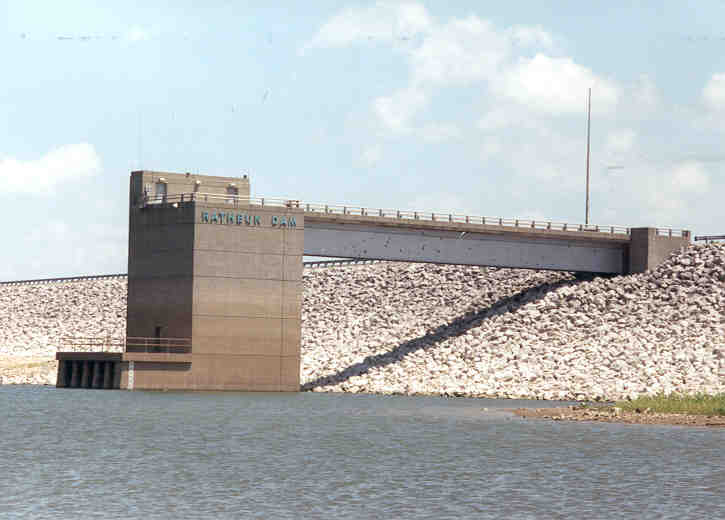
Rathbun Lake, referred to as Little Ocean, is a very windy lake known for sailing and fantastic walleye, bass, and crappie fishing
©US Army Corp of Engineers, Public domain, via Wikimedia Commons – License
● Surface Area: 11,000 acres
● Max Depth: 50 Feet
● Camping/Overnight Available: Yes
● Boating/Docks Available: Yes
● Swimming Permitted: Yes
● Fishing Permitted: Yes
● Best For: Iowa’s List of Impaired Waters, High Wind Lake, Sailing
Rathbun Lake, sometimes called Little Ocean, is a man-made reservoir located in the south-central part of Iowa. Interesting Lake activities include power boating, sailing, canoeing, paddle boarding, water skiing, windsurfing, fishing, golfing, hunting, and camping. Are you searching for a more upscale experience? Check in to The Honey Creek Resort, providing luxury amenities including an excellent golf course.
Rathbun Lake’s one-hundred-and-fifty-mile shoreline presents a great opportunity for anglers looking to catch their limit. Anglers report large and plentiful walleye, bass, and crappie. Other species are sunfish, hybrid stripers, channel catfish, and largemouth bass. Take some time for a self-guided tour of the dam’s fish hatchery available to the public.
Wildlife enthusiasts, birdwatchers, and hunters enjoy the sixteen thousand acres of Wildlife Management Areas available around Rathbun Lake. A few bird species known to frequent the lake include the black-billed cuckoo, bobolink, Forster’s tern, Henslow’s sparrow, least tern, loggerhead shrike, osprey, and bald eagle. Be aware, hunting is allowed in designated areas for deer, turkey, pheasants, ducks, and geese.
Saylorville Lake
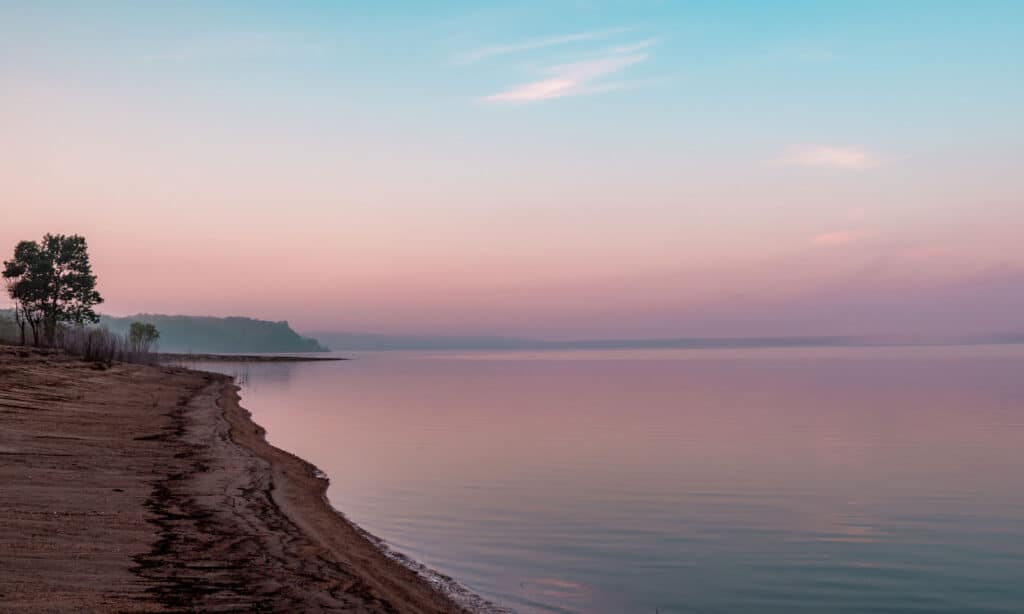
Originally created to assist with flood control, Saylorville Lake now provides fishing, camping, and hunting to Des Moines residents and tourists
©Bella Bender/Shutterstock.com
● Surface Area: 5,950 acres
● Max Depth: 37 Feet
● Camping/Overnight Available: Yes
● Boating/Docks Available: Yes
● Swimming Permitted: Yes
● Fishing Permitted: Yes
● Best For: Bass Fishing, High-Speed Boating, Butterfly Garden, Hunting
Saylorville Lake is situated in central Iowa north of the city of Des Moines. A man-made reservoir, originally created to help with repeated flooding in the area. Plan ahead for your next fishing trip, and check the current water levels as they vary frequently.
Saylorville Lake connects to the Des Moines River, providing an enormous area for fishing and hunting. In addition, it provides six boat launches for anglers to hook black bass, bluegill, channel catfish, crappie, largemouth bass, perch, striped bass, sunfish, walleye, and white bass. Interested in waterfowl hunting and controlled bowhunting for antler-less deer? Jester Park is open specifically to meet these needs.
The nature lover’s paradise of twenty-six thousand-acre provides wildlife everywhere. Birds flying around the lake include black-tailed gulls, Pacific loons, black vultures, and bald eagles. Looking for a family-friendly attraction? The butterfly garden, near the visitor center on Neal Smith Trail, is a perfect stop for all ages.
Big Spirit Lake
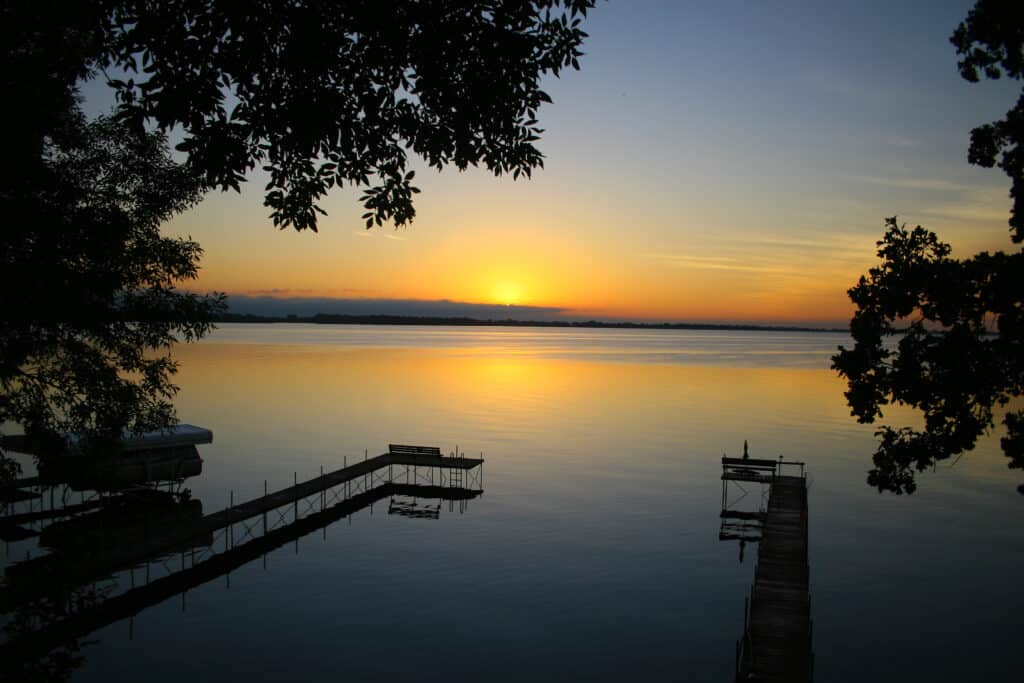
Big Spirit Lake is the largest natural lake in Iowa and the biggest in the chain of lakes known as the Iowa Great Lakes.
©Karl Kraut/Shutterstock.com
● Surface Area: 5,684 acres
● Max Depth: 22 Feet
● Camping/Overnight Available: Yes
● Boating/Docks Available: Yes
● Swimming Permitted: Yes
● Fishing Permitted: Yes
● Best For: Largest Natural Lake In Iowa, Panfish & Walleye Fishing, Largest of Iowa’s Great Lakes
The name of Big Spirit Lake–the largest in the chain of lakes known as the Iowa Great Lakes–comes from the story of an evil entity once living within the lake’s waters. The Great Lakes system in Iowa also includes East Okoboji and West Okoboji; all are great fishing lakes!
Panfish and walleye are prime targets for anglers at Big Spirit Lake. Fish of many other types grace the lake’s fifteen miles of shoreline: bigmouth buffalo, black bullhead, black crappie, bluegill, channel catfish, common carp, freshwater drum, green sunfish, largemouth bass, longnose gar, muskellunge, northern pike, quillback, shortnose gar, smallmouth bass, white bass, white sucker, yellow bass, and yellow perch.
Get your bird-watching goggles out! Explore Kettleson Hogsback Wildlife Management Area to see a wide variety of birds. Big Spirit Lake is home to over two hundred and seventy species of birds including loons, flycatchers, sparrows, allies, blackbirds, canvasbacks, black terns, red-necked grebes, yellow-headed blackbirds, pelicans, trumpeter swan, ruddy duck, red-necked grebe, American bittern, upland sandpiper, black tern, black-billed cuckoo, belted kingfisher and prothonotary warbler.
West Okoboji Lake

West Okoboji Lake is the deepest lake in Iowa known for outstanding yellow perch, bluegill, and walleye fishing; and it has an amusement
park
!
©kbrighton/Shutterstock.com
● Surface Area: 3,847 acres
● Max Depth: 138 Feet
● Camping/Overnight Available: Yes
● Boating/Docks Available: Yes
● Swimming Permitted: Yes
● Fishing Permitted: Yes
● Best For: Boating, Fishing, Deepest Lake In Iowa, Designated Outstanding Iowa Water, Arnolds Park Amusement Park
West Okoboji Lake is the deepest lake in Iowa, making it an extremely popular destination for boaters, skiing and sailing. It’s a natural body of water with nearly twenty miles of shoreline, positioned in northwestern Iowa.
Fishing is exceptional at West Okoboji Lake with a wide range of species in the lake’s waters. Anglers regularly pull yellow perch, bluegill, and walleye from the lake. Other species are known to inhabit West Okoboji Lake: black crappie, channel catfish, largemouth bass, muskellunge, northern pike, smallmouth bass, white bass, and yellow bass.
West Okoboji Lake and the whole Iowa Great Lake area are the perfect environment for a diverse range of birds and other wildlife. Some of the birds regularly seen flying around the lake include red-necked phalarope, snow geese, Canadian geese, trumpeter swan, gadwall, mallard, northern pintail, green-winged teal, canvasback, redhead, ring-necked duck, and lesser scaup. West Okoboji Lake offers something for everyone with hunting, snowmobiling, cross-country skiing, ice skating, or a day at the Arnolds Park Amusement Park.
Clear Lake
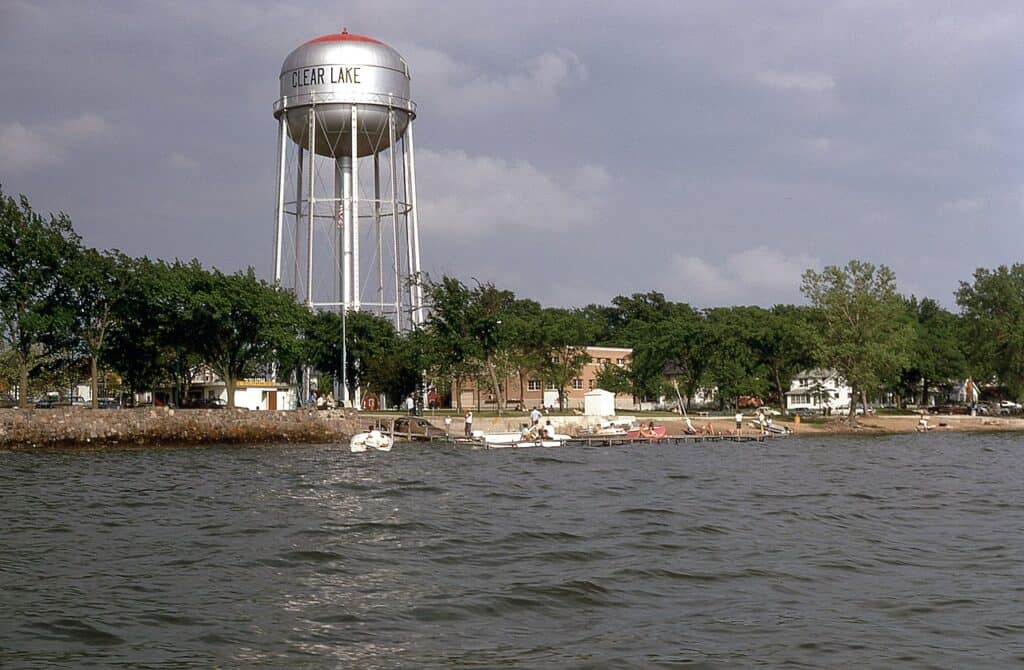
Clear Lake
is a natural spring-fed lake with very high winds for sailing and great walleye, yellow bass, and channel catfish fishing
©Susan J. Koscielak / FortepanIowa / Creative Commons – License
● Surface Area: 3,684 acres
● Max Depth: 30 Feet
● Camping/Overnight Available: Yes
● Boating/Docks Available: Yes
● Swimming Permitted: Yes
● Fishing Permitted: Yes
● Best For: “Best Iowa Lake Town”, Midwest Living “A Top Vacation Spot”, Sailing, Clear Lake Yacht Club
Clear Lake is a natural spring-fed body of water located in the central northeast area of Iowa. This is the site of the famous plane crash of Rock & Roll legends Buddy Holly and Ritchie Valens, popular in the fifties. High winds at the lake are utilized for The Clear Lake Yacht Club; during peak times boats, can be seen racing for miles.
Fourteen miles of shoreline entice anglers hoping to hook one of the primary species in the lake’s water: walleye, yellow bass, and channel catfish. One might also find bigmouth buffalo, black crappie, bluegill, common carp, flathead catfish, green sunfish, and largemouth bass in Clear Lake. The four boat ramps around the lake allow a top-notch fishing or water sports experience.
Wildlife and many types of birds inhabit Clear Lake and the surrounding area. Birdwatchers look for goldfinches, northern cardinals, black-capped chickadees, house finches, downy woodpeckers, hairy woodpeckers, red-bellied woodpeckers, and white-breasted nuthatches. Hunting for ducks or geese is permitted on this completely public land.
Okamanpeedan Lake
● Surface Area: 2,200 acres
● Max Depth: 6.5 Feet
● Camping/Overnight Available: Yes
● Boating/Docks Available: Yes
● Swimming Permitted: Yes
● Fishing Permitted: Yes
● Best For: Notable Heron Population, Northern Pike Fishing, Shallow Water, Walleye Fishing
Okamanpeedan Lake, sometimes called Tuttle Lake, is located on the northern border of Iowa spanning all the way into Minnesota. The lake is quite shallow and historically notable for its large heron population. Local anglers know the lake to be productive for northern pike and walleye.
Several boat ramps are found around the lake’s twelve-mile shoreline. Take note boaters! The lake is quite shallow providing a maximum depth of just over six feet. Yellow perch and black bullhead are in abundance. Not to worry though, variety abounds with white crappie, walleye, bluegill, largemouth bass, and smallmouth bass found.
The connected fifteen-acre Okamanpeedan State Park is home to an extensive list of different types of birds Just a few that lake visitors expect to view include diving ducks, bald eagle, trumpeter swan, mourning dove, killdeer, pectoral sandpiper, lesser yellowlegs, ring-billed gull, black tern, double-crested cormorant, and the American white pelican. The lake’s name translates to “nesting place of the herons” reflecting the abundance of the bird frequently seen at Okamanpeedan Lake.
East Okoboji Lake
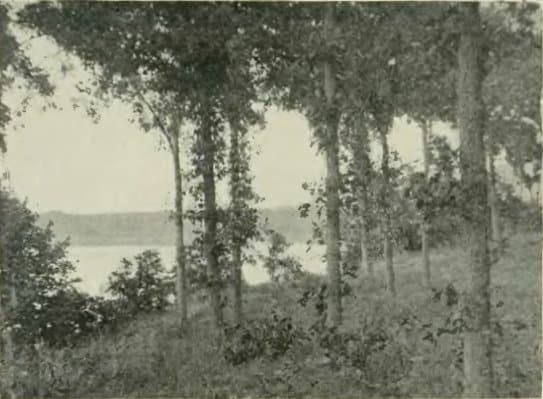
East Okoboji
Lake is the longest
natural body of water in the state of Iowa and is known for great bullhead and bluegill fishing!
©Published in above-mentioned work, which was by Benjamin F. Gue, Public domain, via Wikimedia Commons – License
● Surface Area: 1835 acres
● Max Depth: 21 Feet
● Camping/Overnight Available: Yes
● Boating/Docks Available: Yes
● Swimming Permitted: Yes
● Fishing Permitted: Yes
● Best For: Bullhead & Bluegill Fishing, Longest Natural Lake In Iowa
East Okoboji Lake is a water-filled glacial pothole, roughly thirteen thousand years old. It’s a long and narrow body of water, almost like a river, and it’s the third largest lake in Iowa’s “chain of lakes”. The lake’s precious water laps against the seventeen miles of shoreline creating the perfect environment for bullhead and bluegill.
Anglers enjoy the less busy atmosphere of East Okoboji Lake in contrast to the other larger lakes in close proximity. Bullhead catfish and bluegill are the top species in the lake, however, several others are present including crappie, muskellunge, pike, sunfish, walleye, white bass, and yellow perch. Be sure to check regulations on East Okoboji Lake for daily limits and size restrictions.
The serene, less traveled East Okoboji Lake area is a prime retirement destination with houses lining much of the shore. A boat ramp and pier are available for fishing and other activities such as wildlife viewing and birdwatching. Visitors camp at Bedell State Park, one of the newest camping facilities in the entire state!
Lost Grove Lake
● Surface Area: 400 acres
● Max Depth: 50 Feet
● Camping/Overnight Available: No
● Boating/Docks Available: Yes
● Swimming Permitted: No
● Fishing Permitted: Yes
● Best For: Iowa’s Newest Lake, Dove & Pheasant Hunting, Jetty & Shoreline Fishing, No-Wake Lake, ADA Accessible Shoreline Fishing
Lost Grove Lake is the newest lake in Iowa located in the southeast area of the state near the Illinois border. Paddling and fishing were first in mind when the lake was created; ADA compliance was also at the top of the list. No-wake regulations and small horse-powered engines maintain the pristine, and serene atmosphere Lost Grove Lake visitors love.
The stunning water quality of the lake’s water provides a home to a range of fish species, many stocked often. The most abundant catches at Lost Grove Lake are largemouth bass, black crappie, and bluegill. Other types of fish found in the lake include channel catfish, muskellunge, redear sunfish, walleye, and white crappie.
Lost Grove Lake provides an assortment of amenities including a pier, jetty, five public parking lots, three boat ramps, and three ADA-compliant fishing trails that are accessible by wheelchair. Many types of wildlife are viewed at the lake, from herons to swallows and even dragonflies! Pheasant and dove hunting is said to be outstanding during the autumn season.
Iowa’s Peaceful, Quaint, Secret Lost Lake
Lost Island Lake
● Surface Area: 1,200 acres
● Max Depth: 16 Feet
● Camping/Overnight Available:
● Boating/Docks Available: Yes
● Swimming Permitted: Yes
● Fishing Permitted: Yes
● Best For: Iowa’s Sixth Largest Natural Lake, Excellent Shore Fishing, Accessible Pier, Bullhead Catfish & Walleye Fishing
Anglers and families looking for a quiet, relaxing lake with fewer people and smaller crowds have found a winner with Lost Island Lake. The lake is located just north of quaint and lovely Ruthven, in the northwestern part of the state, about a half-hour from Iowa’s Great Lakes. The small town of Ruthven has been described as “small-town living at its finest“; the lake’s atmosphere matches.
The lake’s serene and peaceful environment provides fantastic bullhead and walleye fishing. Several other types of fish are present in Lost Island Lake including northern pike, walleye, white bass, yellow bullhead, and yellow perch. Lost Island Lake has a seven-mile shoreline and is a glacially formed, water-filled, shallow bowl-shaped basin.
The five thousand-acre wetland area surrounding Lost Island Lake is top-notch for birdwatchers, with approximately three hundred known species recorded, and known as one of the top birding areas in the Midwest. Just a few of the types of birds you might see in flying around Lost Island Lake are rose-breasted grosbeaks, Baltimore orioles, blue jays, yellow warblers, gray catbirds, American redstarts, eastern wood-pewee, great crested flycatcher, and house wrens. If all that weren’t enough, Lost Island Lake also has many ADA-accessible amenities including extremely easy shore fishing.
Largest Lake In Iowa
Lake Red Rock

The waters of Iowa’s largest body of water, Lake Red Rock, rest where five towns used to serve small communities until 1969 when a dam was created to aid with flood prevention in the area.
©U.S. Army Corps of Engineers, photographer not specified or unknown, Public domain, via Wikimedia Commons – License
● Surface Area: 70,016 acres
● Max Depth: 55 Feet
● Camping/Overnight Available: Yes
● Boating/Docks Available: Yes
● Swimming Permitted: Yes
● Fishing Permitted: Yes
● Best For: Fishing, Birdwatching, Swimming, Notable White Pelican Population, Lost Towns Under Lake Red Rock
Lake Red Rock is named for a town that once stood where the lake’s waters flow today. The lake was originally created in 1969 for flood prevention and is now Iowa’s premier destination for crappie fishing, swimming, and birdwatching. Five towns in total actually occupied the area where the lake rests now; they’re known as the Lost Town Under Lake Red Rock.
In addition to the outstanding crappie fishing offered by Lake Red Rock, white bass, black bass, bluegill, catfish, and walleye are all popular catches. Lake Red Rock provides camping and boat launch options along the lake’s seventy-five-mile shoreline. Ice fishing in the winter may also strike your fancy.
The thirty-five thousand acres of breathtaking wilderness surrounding the lake is one of Iowa’s best bird-watching areas. Just a few of the many bird types spotted at Lake Red Rock are bald eagles, herons, egrets, pelicans, gulls, and ducks. The thirty-two-acre Gladys Black Bird Refuge provides a home to a vast array of many other bird species.
Summary of 10 Interesting Iowa Lakes
| Lake | Best For | |
|---|---|---|
| 1 | Rathbun Lake | Iowa’s List of Impaired Waters, High Wind Lake, Sailing |
| 2 | Saylorville Lake | Bass Fishing, High-Speed Boating, Butterfly Garden, Hunting |
| 3 | Big Spirit Lake | Largest Natural Lake In Iowa, Panfish & Walleye Fishing, Largest of Iowa’s Great Lakes |
| 4 | West Okoboji Lake | Boating, Fishing, Deepest Lake In Iowa, Designated Outstanding Iowa Water, Arnolds Park Amusement Park |
| 5 | Clear Lake | “Best Iowa Lake Town”, Midwest Living “A Top Vacation Spot”, Sailing, Clear Lake Yacht Club |
| 6 | Okamanpeedan Lake | Notable Heron Population, Northern Pike Fishing, Shallow Water, Walleye Fishing |
| 7 | East Okoboji Lake | Bullhead & Bluegill Fishing, Longest Natural Lake In Iowa |
| 8 | Lost Grove Lake | Iowa’s Newest Lake, Dove & Pheasant Hunting, Jetty & Shoreline Fishing, No-Wake Lake, ADA Accessible Shoreline Fishing |
| 9 | Lost Island Lake | Iowa’s Sixth Largest Natural Lake, Excellent Shore Fishing, Accessible Pier, Bullhead Catfish & Walleye Fishing |
| 10 | Lake Red Rock | Fishing, Birdwatching, Swimming, Notable White Pelican Population, Lost Towns Under Lake Red Rock |
The photo featured at the top of this post is © Bella Bender/Shutterstock.com
FAQs (Frequently Asked Questions)
Which lakes make up the "Great Lakes' system of Iowa?
Big Spirit Lake, East Okoboji and West Okoboji Lakes make up Iowa’s Great Lakes system.
Where can I find the Little Ocean of Iowa?
Rathbun Lake is known as the Little Ocean in Iowa.
Thank you for reading! Have some feedback for us? Contact the AZ Animals editorial team.






